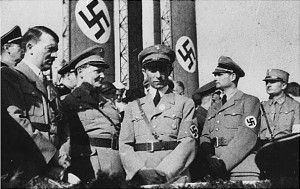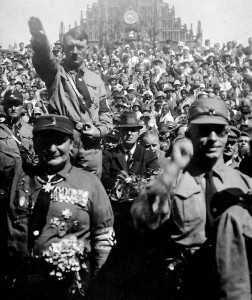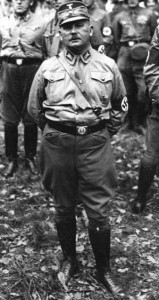 Many students and scholars labor under the assumption that once Hitler became Chancellor of Germany, he immediately assumed full dictatorial control of the country. However, this is not an accurate assessment. There were quite a number of steps that Hitler employed to consolidate his power, many of which were devious and violent. Of all the steps he had taken, the events during the Night of the Long Knives were among the most brutal.
Many students and scholars labor under the assumption that once Hitler became Chancellor of Germany, he immediately assumed full dictatorial control of the country. However, this is not an accurate assessment. There were quite a number of steps that Hitler employed to consolidate his power, many of which were devious and violent. Of all the steps he had taken, the events during the Night of the Long Knives were among the most brutal.
The Night of the Long Knives
The Night of the Long Knives involved the violent purge of certain members of the Nazi Party from June 30th to July 2nd in 1934. Called the Nacht der langen Messer in Germany, this event occurred over a series of days and entailed the Nazi regime’s murder of those Hitler considered to be political enemies. In particular, those targeted belonged to the Strasserist, a left wing faction of the Nazi Party that Hitler distrusted.
Those killed during these events included leaders and major figures in the Strasserist such as Kurt von Schleicher (a former Chancellor), Gustav Ritter von Kahr, and Gregor Strasser. Also targeted and killed were the main leaders of the Sturmabteilung (SA), a paramilitary organization of the Strasserist which operated in a manner similar to the Brownshirts of Mussolini’s fascist regime in Italy.
After the Night of the Long Knives, Hitler had eliminated both real and perceived opposition in the Nazi Party. He was able to put his main loyalists in charge of various operations in the German government and further expand his ability to control the government and the populace.
The Enabling Act Was Not Enough
 Prior to the Night of the Long Knives, Hitler had gained a massive amount of power thanks to the Enabling Act. This act, for all intents and purposes, nullified any checks and balances on Hitler. He was able to pass laws without any input from parliament and Judicial review of Hitler’s actions was nonexistent. All of these actions were achieved through convincing the populace an existential threat was present in the form of communist subversives.
Prior to the Night of the Long Knives, Hitler had gained a massive amount of power thanks to the Enabling Act. This act, for all intents and purposes, nullified any checks and balances on Hitler. He was able to pass laws without any input from parliament and Judicial review of Hitler’s actions was nonexistent. All of these actions were achieved through convincing the populace an existential threat was present in the form of communist subversives.
The Enabling Act, however, was not enough for Hitler. He still felt threatened by left wing factions within his own party. This led Hitler to order the purge of the Nazi Party of those he felt would be a dire threat to him.
Fear of the SA
Fear of the SA also contributed to Hitler’s desire to purge their ranks. The SA was a notoriously violent Nazi faction which, at points, even terrorized innocent citizens of Germany. The actions of this organization helped keep the populace of Germany in line. The ranks of the SA were huge, including over 2 million men. While no plans existed to overthrow or even mildly oppose Hitler, fears and concerns did exist regarding what might happen if the SA became disloyal to the German leader.
Hitler also had great concerns over the loyalty of the German Army. The Army was comprised of massive numbers of men and not very many in the Army held Hitler in high regard since he was only a corporal when he served in World War I. Hitler knew he needed a loyalty oath from the Army or else his control over it would always be in question. This would make his plans in Germany and outside of its domestic borders very difficult. Hitler needed to take steps to deal with these issues.
From this, the Night of the Long Knives was born.
The Stage is Set for the Purge
Ernst Röhm was the leader of the SA and a very powerful man in Germany. He was loyal to Hitler’s ideals and was not seeking power outside his current position. However, major figures in the Nazi Party such as Goering, Himmler, and Goebbels were concerned about Röhm gaining too much power and influence. Therefore, they convinced Hitler that Röhm was a threat.
Similarly, the army was very concerned about sphere of influence being undermined by the SA. The SA’s ranks were in the range of two million men which outnumbered the army and made its leaders very nervous.
The Launch of the Attacks
Hitler, still wishing to acquire an oath of loyalty from the army, saw the army’s distrust of the SA as the opening for an opportunity. Hitler promised army officials that the members of the SA would fall under the control of the army, if the army would help him remove Röhm and other SA leaders. In turn, the army would be required to swear an oath of allegiance to Hitler. The army agreed to the terms and the stage was set for the purge to begin.
On June 29, 1934, the Nazi SS arrested several leaders of the SA along with others considered political threats to Hitler. The total amount of the arrests was likely in the hundreds. 85 of the men were executed including Röhm who was killed at gun point in prison. Some of those that were executed were literally beaten to death. Certain historians believe the figure of 85 was merely the announced figure and the actual number of those executed was significantly higher.
The Aftermath
In the aftermath of the Night of the Long Knives, the SA was no longer a real or perceived threat to Hitler. It was under the control of the army and Hitler finally received his sought after loyalty oath.
Few would be willing to challenge Hitler after these events as he and his cohorts clearly showed how ruthless they would be against any dissent.
With full control of the army, Hitler could now make plans for wars of conquest. In many ways, the events of the Night of the Long Knives were seminal in terms of setting the stage for the military actions that would launch World War II.
